Are the Oscars still too white? Data shows little progress.

As the 94th Academy Awards approaches this Sunday, fans and critics alike question whether the Oscars are truly becoming more inclusive or whether the long-running award show will fail once again in that category.
Here’s how the nominations work:
The Academy of Motion Picture Arts and Sciences has more than 10,000 members with almost 9,500 of those eligible to vote on the Oscars.
Within the Academy, there are different voting branches for each category at the Academy Awards. Variety reports that the Academy is made up of 17 branches, and each member belongs to one of the 17 branches.
These branches give members the opportunity to vote in their own fields, and how many votes an individual needs to secure a nomination depends on the size of the voting branch. For example, a film needs more than 100 votes to secure a nomination for the Best Picture category.
The Academy has a history of snubbing diverse films and casts for the industry’s highest awards. The trend came to a head in 2015 when actors, directors, and viewers of the awards show protested its lack of diversity with the hashtag #OscarsSoWhite after the Academy awarded all 20 acting nominations to white actors.
“2015 and 2016, both years completely dry for diverse candidates,” says Kate Karniouchina, professor of business and dean of the Lokey School of Business and Public Policy at Mills College.
In 2016, the New York Times reported that all 20 Oscar nominations in the acting categories went to white performers for the second year in a row, and online, people once again took up the rallying cry: #OscarsSoWhite.
Karniouchina was part of a group of data researchers at Mills College who looked into the disproportionately underrepresented Hollywood industry and the extent to which the Academy Awards contributed to that.
These researchers cited USC Annenberg School for Communication and Journalism, which found that in 2019 that 34.3% of speaking roles were given to underrepresented groups, which is below the U.S. population of 42%.
USC Annenberg also found that the percentage of female-identified speaking characters did not meaningfully increase, only reaching 34.3% in 2019 compared to 29.9% in 2007.
Change in representation since 2015
Underrepresented leads in film
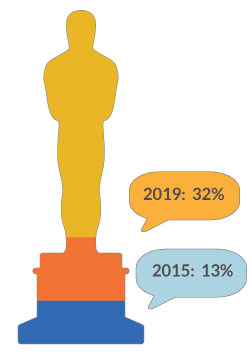
Underrepresented in the academy
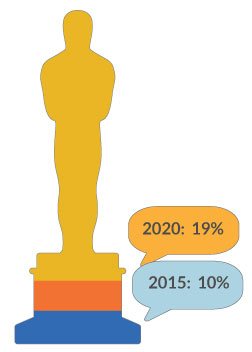
Women speaking characters in film
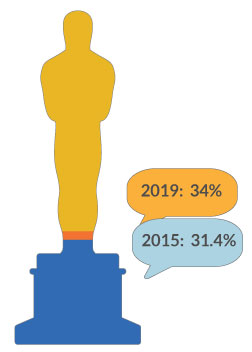
Women in the academy
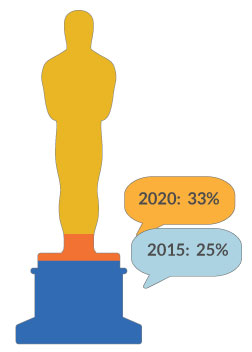
It wasn’t until 2020 that the Academy promised to make significant changes.
The Academy said it would triple its ranks of active members from underrepresented racial communities. By 2020, active members from those groups rose to 19%, up from 10% in 2015. It added to the number of active women members, from 25% in 2015 to 33% in 2020.
“A very key thing happened the year after #OscarsSoWhite,” says Venkat Kuppuswamy, assistant professor of entrepreneurship and innovation at Northeastern. “The academy made a push to increase the diversity of its membership, and I think that’s now paying dividends.”
In terms of diversity for Oscar nominations, the tide started to shift ever so slightly in 2019, when the academy reported a 17 percent increase in the number of nominated films with people of color.
But 2020 was a different year for the Oscars after the academy reported major changes in terms of diversifying its nominations. Seven branches nominated more women than men. Five branches nominated many of the candidates from underrepresented ethnic and racial communities, and 13 branches nominated the majority of their candidates from international regions.
“People like seeing themselves represented in any avenue,” Kuppuswamy says. “In an increasingly multicultural society, you want to see that, even in the Oscars.”
This year, there are noteworthy nominations, including the nomination of four Black actors in major categories: Ariana DeBose (“West Side Story”) and Aunjanue Ellis (“King Richard”) for the best-supporting actress, and Will Smith (“King Richard”) and Denzel Washington (“The Tragedy of Macbeth”) for best actor.
Oscar Nominations in 2015 vs 2020
Underrepresented Group
![]()
Majority Group
![]()
Best Actor

Best Actress
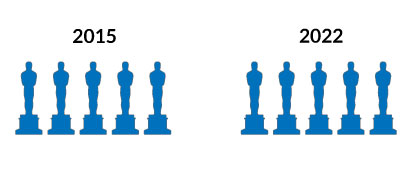
Best Director
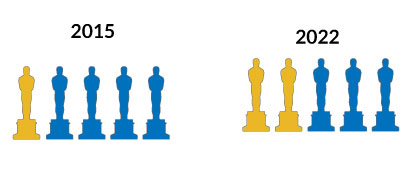
Best Supporting Actor
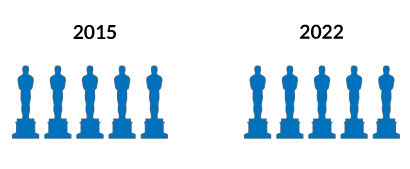
Best Supporting Actress

Best Picture
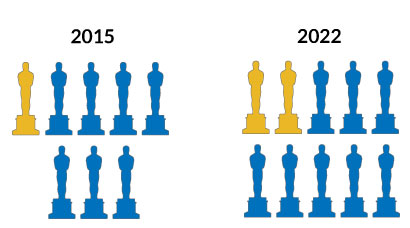
But even this year, USA Today reports that many experts appreciate the Oscar nominations but still believe that voting members of the Academy of Motion Picture Arts and Sciences have once again missed the mark.
For the 2022 ceremony, the Academy announced that all nominees for best actress and best supporting actor are white. And while 2021 marked the first time that more than one woman was nominated for best director, Jane Campion (“The Power of the Dog”) is the sole female filmmaker nominated this year.
“It doesn’t mean that we still don’t have some barriers,” Karniouchina says. “If you look at the overall proportions, there’s a long way to go.”






